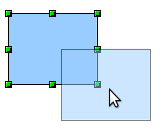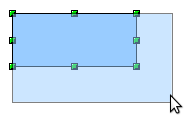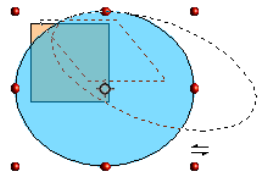Moving and Dynamically Adjusting an Object’s Size
- What is Draw?
- Parts of the main Draw window
- Choosing and defining colors
- Positioning objects with Snap functions
- Positioning objects with guiding lines
- The basic drawing shapes
- Drawing geometric shapes
- Selecting objects
- Moving and dynamically adjusting an object’s size
- Editing objects
- Using styles
- Special effects
- Combining multiple objects
- Aids for positioning objects
- Inserting and editing pictures
- Working with 3D objects
- Exporting graphics
- Adding comments to a drawing
Moving and Dynamically Adjusting an Object's Size
There are several ways of moving or changing the size of an object. The dynamic method described here uses the mouse.
When you dynamically change an object, remember to check the left-hand area of the status bar at the bottom of the Draw window. This area shows detailed information about the ongoing manipulation. This information changes when the mouse is moved.
Dynamic Movement of Objects
| To move an object, select it and then click within the object's border and hold down the left mouse button while dragging the mouse.
During movement, the shape of the object appears a faded version of the shape to help with repositioning. To drop the object at its new location, release the mouse button. The new position appears immediately in the Status Bar. |
Dynamic Size Modification of Objects
| To change the size of a selected object (or group of selected objects) with the mouse, move one of the handles located around the selection. As shown in the following illustration, a faded version of the new object shape is shown. |
The results depend on which handle you use. To resize an object along one axis, use the appropriate side handle. To resize both axes, use a corner handle. The new size appears immediately in the status bar.
Rotation
Rotating an object lets you move the object around an axis. To do this dynamically (with the mouse), use the red handles, as you do when changing the size of the object. To get the red handles, click once on the object to select it and then click once on a green handle.
To rotate an object (or a group of objects), drag the red corner handle point of the selection with the mouse. The mouse cursor takes the shape of an arc of a circle with an arrow at each end. A faded version of the object being rotated appears and the current angle of rotation is dynamically shown in the status bar.
Rotations are made around an axis which is displayed as a small symbol, as shown in Figure 153. You can move the axis of rotation with the mouse.
If you hold down the Shift key during the rotation, the operation will be carried out in increments of 15°.
Inclination and Perspective
To slant or shear objects, use the red handles located at the midpoint of an edge of the selected objects. The mouse pointer changes to a [[Image:]] when the pointer hovers over one of these midpoint handles. Not every object can be slanted.
| Content on this page is licensed under the Creative Common Attribution 3.0 license (CC-BY). |



